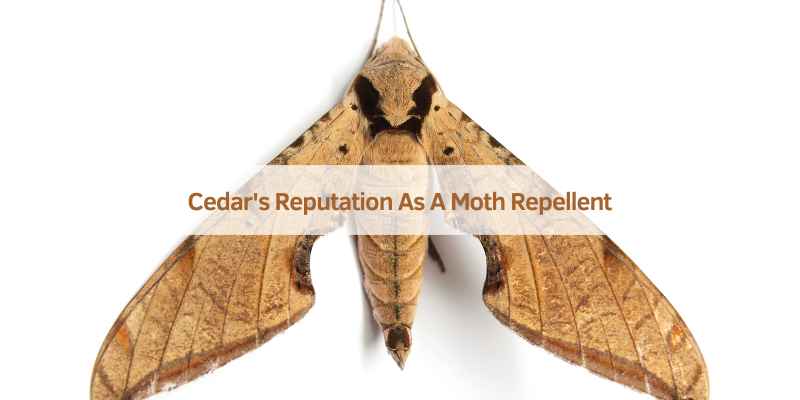Cedar has the potential to repel moths, but it is unlikely to be effective on its own. Mothballs should only be used as a last resort.
However, cedarwood oil and cedarwood products, such as cedar blocks or cedar rings, can help deter moths and prevent costly moth issues in your wardrobe or drawers. Cedar has the ability to absorb moisture and eliminate odors, making it a useful deterrent for moths.
Additionally, the strong scent of cedar oil can repel moths from damaging clothes and other fabrics. Using cedar as a preventive measure can be beneficial in keeping moths at bay.
Cedar’s Reputation As A Moth Repellent
Cedar has a reputation as a moth repellent due to the insect-repelling power of its oil. While cedar and other herbal scents may help deter moths, they may not be effective on their own against moths or their larvae. Cedarwood oil and cedar planks can kill and repel moths, but mothballs should be used only as a last resort.
Historical Use Of Cedar For Moth Prevention
Cedar has been used for centuries as a natural remedy to repel moths and protect clothing and other items from damage. In ancient civilizations such as Egypt and Rome, cedar wood was prized for its ability to ward off pests, including moths. The aromatic scent of cedar has long been known to be displeasing to these insects, making it an ideal choice for keeping them at bay.
Myths Versus Facts About Cedar’s Effectiveness
There are several myths surrounding cedar’s effectiveness as a moth repellent, but it’s important to separate fact from fiction. Let’s take a closer look at the truth behind these claims:
1. Myth: Cedar kills moths
Fact: While cedar can repel moths, it does not necessarily kill them. The strong scent of cedar oil is what deters moths from laying their eggs on clothing or other materials. However, it’s important to note that cedar’s effectiveness may diminish over time as the scent dissipates.
2. Myth: Any type of cedar works
Fact: Not all types of cedar are equally effective at repelling moths. The Eastern Red Cedar (Juniperus virginiana) is known to have the strongest moth-repelling qualities. Other types of cedar, such as Western Red Cedar or Spanish Cedar, may not be as effective.
3. Myth: Cedar is the only solution
Fact: While cedar can be a useful tool in preventing moth infestations, it should not be relied upon as the sole solution. Proper storage and regular cleaning of clothing and other items are equally important in preventing moth damage. Additionally, there are other natural remedies and preventive measures that can be taken, such as using lavender or storing items in airtight containers.
In conclusion, cedar has a long-standing reputation as a moth repellent, and its use can be effective in deterring these pests. However, it is important to understand the limitations and use cedar in conjunction with other preventive measures to ensure the best results in protecting your belongings from moths.

Understanding Moths And Their Aversion To Cedar
Cedar’s natural aroma acts as a deterrent to moths, especially in repelling them from laying eggs. Cedarwood oil and Eastern Red Cedar are proven moth-repelling options, making cedar a beneficial choice to prevent costly moth damage. Using cedar rings, planks, or sachets in wardrobes can effectively combat moth issues.
The lifecycle of clothes moths can be broken down into four stages: egg, larva, pupa, and adult. Clothes moths are particularly drawn to dark, undisturbed areas where they can lay their eggs on natural fibers like wool or silk.
The Lifecycle Of Clothes Moths
1. Egg: Clothes moths start as tiny, oval-shaped eggs that are often laid in hidden spots.
2. Larva: Once the eggs hatch, larvae emerge and feed on fabrics, creating damage.
3. Pupa: Larvae then spin cocoons to undergo metamorphosis into adult moths.
4. Adult: Adult moths do not feed on fabrics but focus on reproduction, starting the cycle anew.
Why Cedar Might Deter Moths
Cedar is a natural moth deterrent due to the aromatic compounds present in the wood. Moths find the strong scent of cedar unpleasant and avoid laying their eggs near it. The volatile oils in cedar, such as cedrol, are responsible for the repellent effect.
In addition to its aromatic properties, cedar also has moisture-absorbing qualities, making it an effective solution for keeping clothes and closets dry and free from musty odors that attract moths. Cedarwood oil can be used in various forms, including cedar blocks, cedar balls, or cedar hangers, to protect clothes from moth infestations.
Cedarwood Oil: The Active Moth Repelling Agent
When it comes to natural moth repellents, cedarwood oil stands out as a powerful and effective solution. The properties of cedarwood oil make it a potent agent for repelling moths, protecting your clothes and linens from damage. Let’s delve into the key properties of cedarwood oil and understand how its potency affects moth repellence.
Properties Of Cedarwood Oil
Cedarwood oil is derived from various types of cedar trees, such as Eastern Red Cedar and Texas Cedarwood. It contains natural compounds, such as cedrol and alpha-cedrene, which are responsible for its distinct aroma and insect-repelling properties. The strong, woody scent of cedarwood oil is highly effective at repelling moths and preventing them from laying eggs on clothing and fabrics.
The oil also has antimicrobial properties, which can help to inhibit the growth of mold and mildew, further protecting your clothes and linens from damage.
How Oil Potency Affects Moth Repellence
The potency of cedarwood oil plays a crucial role in its effectiveness as a moth repellent. Higher concentrations of cedrol and other active compounds in the oil result in a stronger and longer-lasting scent, which enhances its ability to repel moths.
When choosing cedarwood oil products for moth repellence, it’s important to consider the concentration of the oil. Higher concentrations or pure cedarwood oil are more potent and provide better protection against moths compared to products with lower oil content.
Varieties Of Cedar And Their Repellent Qualities
When it comes to moth prevention, cedar has long been praised for its natural repellent qualities. Different varieties of cedar offer varying degrees of effectiveness in repelling moths. Let’s explore the specific repellent qualities of some popular cedar species.
Eastern Red Cedar For Moth Prevention
The Eastern Red Cedar, scientifically known as Juniperus virginiana, is renowned for its potent moth-repelling qualities. This variety of cedar releases aromatic oils that effectively deter moths from infesting your clothes and linens. The scent of Eastern Red Cedar is particularly offensive to moths, making it an excellent natural deterrent.
Comparing Different Cedar Species
When it comes to comparing different cedar species for moth prevention, it’s essential to consider the specific repellent qualities of each variety. While Eastern Red Cedar is a popular choice, other cedar species such as Western Red Cedar and Spanish Cedar also possess moth-repelling properties. However, the effectiveness of these varieties may vary.
Here’s a quick overview of the moth-repellent qualities of various cedar species:
| Cedar Species | Repellent Qualities |
|---|---|
| Eastern Red Cedar | Potent moth-repelling aromatic oils |
| Western Red Cedar | Moderate moth-repellent properties |
| Spanish Cedar | Relatively effective in deterring moths |
Understanding the unique qualities of each cedar species allows you to make an informed decision when selecting the most suitable option for moth prevention in your home.
Practical Uses Of Cedar In Wardrobes And Storage
Cedar wood is a practical choice for wardrobes and storage as it helps repel moths with its natural scent. The oil of the tree emits a fragrance that moths dislike, preventing them from laying eggs and causing damage to clothes and fabrics.
Using cedar wood rings or sachets in drawers and closets can be an effective deterrent for moths.
Cedar is a versatile and natural solution for deterring moths and protecting your clothes. Let’s explore the practical applications of cedar in wardrobes and storage.
Cedar Hangers And Blocks
Using cedar hangers and blocks in your wardrobe is an effective way to repel moths. The aromatic scent of cedar disrupts the moth’s reproductive cycle, keeping your clothes safe.
Maintaining Cedar’s Effectiveness Over Time
To ensure cedar remains potent, lightly sand cedar blocks or hangers annually. This simple maintenance step rejuvenates the wood’s natural oils, keeping moths at bay.
Cedar’s natural repellent properties make it a popular choice for protecting clothes from moths. By incorporating cedar hangers and blocks into your storage solutions, you can enjoy moth-free closets and fresh-smelling garments.
Alternative Moth Deterrents And Repellents
If you’re looking for an alternative to mothballs, there are a number of natural repellents that can help keep moths away from your clothes and linens. One of the most popular natural moth repellents is lavender, which has a pleasant fragrance that moths find unappealing. Other natural repellents include rosemary, peppermint, and thyme.
Natural Repellents Like Lavender
Lavender is a popular natural moth repellent because of its pleasant fragrance. Moths find the scent of lavender unappealing, so it can be an effective way to keep them away from your clothes and linens. You can use lavender in a number of ways, such as by hanging dried lavender in your closet, placing sachets of lavender in your drawers, or spraying a lavender-infused water on your clothes and linens. Other natural repellents that you can use include rosemary, peppermint, and thyme.
Comparing Cedar With Other Deterrents
Cedar is one of the most popular natural moth deterrents, and for good reason. Cedar contains natural oils that are toxic to moths, but safe for humans and pets. In addition to repelling moths, cedar can also absorb moisture and eliminate odors, making it a versatile choice for keeping your clothes and linens fresh and clean.
When compared to other natural deterrents, cedar has several advantages. For example, lavender and other herbal scents can repel moths, but on their own, they may not be effective against moths or their larvae. Additionally, while mothballs are effective, they can be toxic and should only be used as a last resort. Cedar, on the other hand, is a natural and safe way to keep moths away from your clothes and linens.
In conclusion, cedar is an effective and safe way to repel moths and keep your clothes and linens fresh and clean. By using cedar products such as cedar blocks, hangers, and sachets, you can protect your clothes and linens from moth damage without resorting to toxic chemicals.
The Science Behind Cedar And Moth Control
Cedar is known for its moth-repelling qualities, as the scent of cedar oil deters moths from laying eggs on clothing. Cedarwood oil can kill and repel moths, their caterpillars, and eggs, making it an effective natural deterrent for moth control.
Placing cedar rings in wardrobes or using cedar granules can help prevent costly moth damage.
Research On Cedar’s Impact On Moths
Studies have shown that the oil and wood from Eastern Red Cedar have moth-repelling qualities, deterring clothes moths rather than killing them. The fragrance of cedar is not favored by clothes moths, leading them to avoid laying eggs where the scent is strong. Cedar and cedarwood oil are known to kill and repel moths, moth caterpillars, and eggs. Therefore, incorporating cedar hangers and cedar granules in closets can effectively prevent costly moth issues.
Limitations Of Cedar As A Sole Repellent
While cedar and other herbal scents can repel moths, relying solely on them may not be entirely effective against moths or their larvae. It’s important to note that cedar should be used as a preventive measure rather than as the sole solution for moth control. Mothballs, although effective, should only be considered as a last resort due to their potential toxicity.
Maximizing Cedar’s Moth Repellent Properties
Cedar is a natural and effective moth repellent that can help protect your clothes and linens from damage. To maximize cedar’s moth repellent properties, there are a few key strategies and best practices to keep in mind.
Refreshing Cedar’s Scent
To ensure that cedar remains effective in repelling moths, it’s important to refresh its scent periodically. Over time, the natural oils in cedar that give it its moth-repelling properties may diminish. To refresh the scent of cedar, consider lightly sanding the surface of cedar products or using cedar oil to replenish the fragrance.
Best Practices For Using Cedar Products
When using cedar products to repel moths, it’s essential to employ best practices to optimize their effectiveness. One of the best ways to use cedar is by placing cedar blocks, chips, or sachets in enclosed spaces such as closets, drawers, and storage containers. Additionally, using cedar hangers for clothing can provide ongoing protection against moths.

Frequently Asked Questions
Does Cedar Actually Repel Moths?
Cedar can repel moths due to its scent, but may not be entirely effective on its own. Mothballs are a stronger alternative.
What Is The Best Wood To Repel Moths?
Cedar wood is the best wood to repel moths. The oil of the cedar tree emits a fragrance that the clothes moth dislikes, preventing it from laying eggs. Cedar planks, rings, and granules can be used in closets and drawers to deter moths.
Cedarwood oil can also be effective in killing and repelling moths, caterpillars, and eggs.
What Is The Best Deterrent For Moths?
Cedar wood, specifically the oil and wood from Eastern Red Cedar, is known to repel moths due to the fragrance that the clothes moth dislikes. Cedar wood rings in your wardrobe or drawers can help deter moths. Spritzing carpets with lavender or creating a natural repellent with lavender essential oil and water can also be effective.
Mothballs should only be used as a last resort.
Which Cedar Is Best For Moths?
The best cedar for moths is Eastern Red Cedar, known for its moth-repelling qualities from its oil and wood.
Conclusion
While cedar can help repel moths, it may not be fully effective alone. Mothballs are a stronger alternative. Consider using cedar in conjunction with other methods for best results in moth prevention. Remember, prevention is key to protecting your clothes from moth damage.


